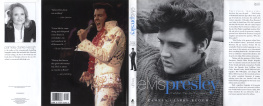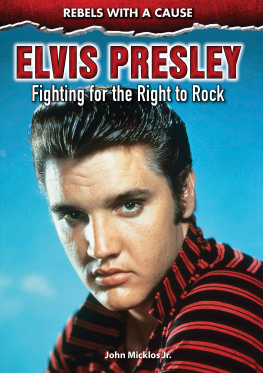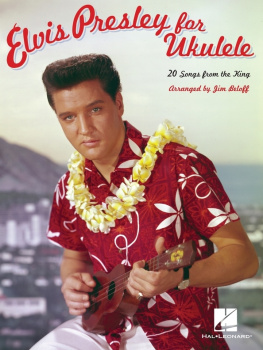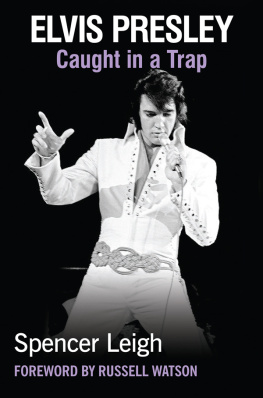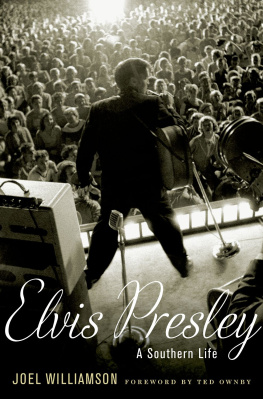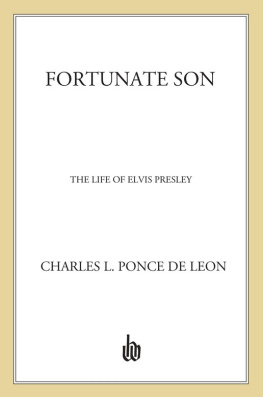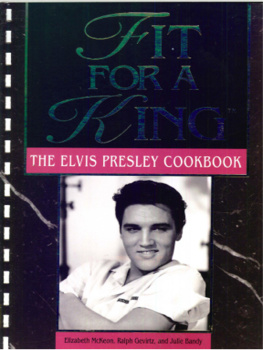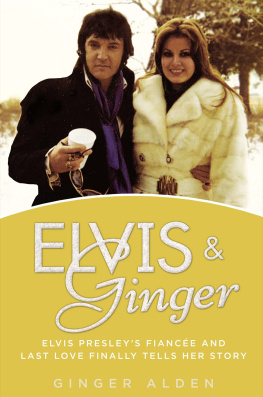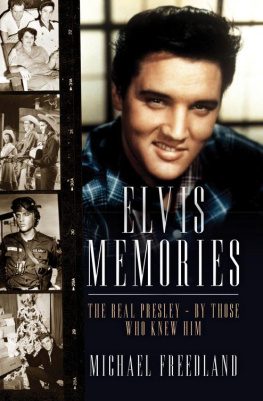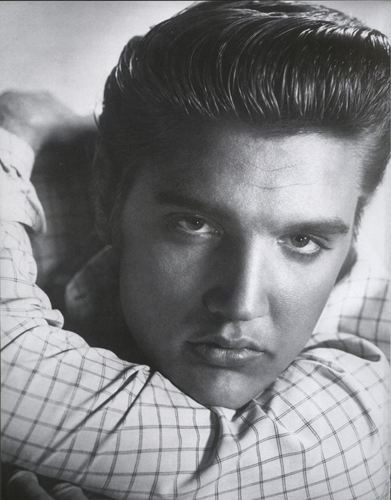elvispresley
The Man The life The Legend
Pamela Clarke Keogh

ATRIA BOOKS
NEW YORK LONDON TORONTO SYDNEY
Also by Pamela Clarke Keogh
Audrey Style
Jackie Style

ATRIA BOOKS
1230 Avenue of the Americas, New York, NY 10020
Copyright 2004 by Pamela Clarke Keogh
www.SimonandSchuster.com
All rights reserved, including the right to reproduce this book or portions thereof in any form whatsoever.
For information address Atria Books, 1230 Avenue of the Americas, New York, NY 10020
ISBN: 0-7434-5603-3
ISBN-13: 978-0-7434-5603-6
eISBN-13: 978-1-439-10815-4
First Atria Books hardcover edition July 2004
10 9 8 7 6 5 4 3 2 1
ATRIA BOOKS is a trademark of Simon & Schuster, Inc.
For information regarding special discounts for bulk purchases, please contact Simon & Schuster Special Sales at 1-800-456-6798 or business@simonandschuster.com
Elvis and Elvis Presley are Registered Trademarks with the USPTO. Copyright 2004 by Elvis Presley Enterprises, Inc.
Photographs and Elvis Presley memorabilia copyright 2004 by Elvis Presley Enterprises, Inc.
The text and viewpoint presented in this book are based entirely upon the authors independent research, and do not reflect the opinions of Elvis Presley Enterprises, Inc.
Manufactured in the United States of America
Dedication
For my brother, Peter C. Keogh, with love and gratitude;
Bernadette Castro, who sang for Berry Gordy;
and Fitzwilliam Michael James Anderson, who is definitely TCB.
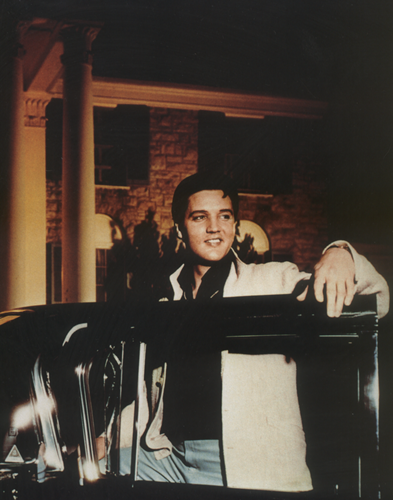
contents
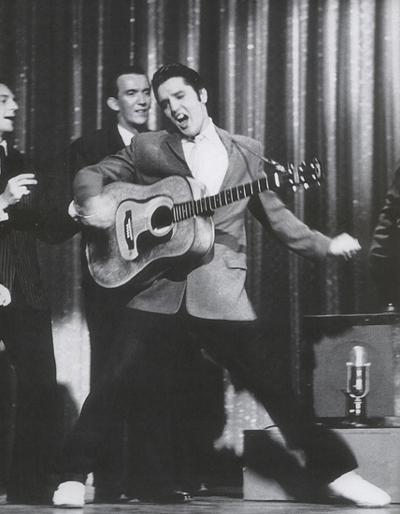
prelude
Before Elvis, there was nothing.
JOHN LENNON
E LVIS P RESLEY WAS ON The Ed Sullivan Show, and the kids did not understand what the fuss was about. If they had even heard of Elvis (Elvis Pretzel singing Heartburn Hotel, some of them thought the deejay said on their little plastic radios), they knew he was a singer whose voice attracted them. They had never heard anything like it. Now, seeing him for the first time playfully blub blub blubbing his way through Dont Be Cruel, they saw he was grown-up, sort of, but a kid like them, too. They could tell by the way he looked at themhe knew them, knew what they were thinking. Elvis Elvis. They said his name and felt the first stirrings of love. He knew what was in their hearts and spoke directly to them.
The adults saw Presley and thought, What the hell was that? If they were particularly threatened, they might shoo the kids away from the television set, as if he were contagious and could somehow teach them about sex through the fuzzy black-and-white image. But since this was 1956, Dad probably just cleared his throat and left the room shaking his head, These crazy kids
Elvis was the first. Before the Beatles, before the Rolling Stones, before U2, before Sean Combs, there was Elvis. The original Slim Shady, he was black and white, rhythm and country, hot and cool. His appearance on Ed Sullivan ripped the 1950s in half, and America was never the same. He could not have seen what was comingthe Colonel, who wanted to make him into sort of a hip Perry Como (if such a thing can be imagined) certainly did not. And for himself, his wildest dream, the one beyond imagining, was to be in the movies like Tony Curtis. But whatever happened, he was game.
In the beginning, Elvis did not understand the audiences ferocious response to him. But he quickly learned to harness it, toying with his screaming fans like a lover. Onstage, something came over him. He was a different personfreer, able to express himself, musically articulate as he never was in conversation. People loved him and he gave their love back to them in kind.
Did the kids even know why they liked Presley? They knew their parents hated him, which was a start. His concerts were an almost Dionysian release. After the placid tones of Frank Sinatra and Tommy Dorsey, rock and roll was a safe place for American teens to go berserk. The great seducer, Elvis left them spent, stunned. They had never seen anything like him: He was so totally different, thats for sure. This beautiful man who loved his mama, wore mascara, and sang like an angel.
The first superstar, Elvis was almost pure style. Tolstoy believed that one critical way to judge art was if it got a responseeither good or bad. Everythingabout Elvis was provocative. His clothes, his hair, the way he sang, the way he moved on stage, his half-kidding sneer. Adults, church leaders, the great dull morass that makes up acceptable society considered Elvis a joke, but Leonard Bernstein recognized his impact. Talking to Richard Clurman, an editor at Time magazine, he proclaimed, Elvis Presley is the greatest cultural force in the twentieth century. What about Picasso? Clurman wondered. This kind of parrying was common at the Time-Life Building. No, Bernstein insisted. Its Elvis. He introduced the beat to everything and he changed everythingmusic, language, clothes. Its a whole new social revolutionthe sixties came from it.
In terms of style, there were three distinct Elvises. The 1950s Hillbilly Cat beloved by fans is considered the purest Elvis. In his slouchy Lansky jacket Presley played country rube to New York City television audiences. The 1960s Hollywood Elvisonscreen, he plays racecar drivers! Roustabouts! Twins!presented a more clean cut (some would say neutered) Elvis acceptable to middle America. And finally, there was the 1970s Vegas Elvisthe glitz, the glamour, the behind-the-scenes shenanigans. Elvis is no longer the wide-eyed country boy happy to be here. Spend enough time in Oz and you just know there is some heavy stuff going down. In Bill Belews hand-studded jumpsuits, Elvis is no longer a singer, but the greatest entertainer in the world. He is quite simply, the King of Rock and Roll.
E LVIS BLEW INTO the complacent center of the 1950s and tore them apart. Like Audrey Hepburn, Grace Kelly, and Jacqueline Kennedy Onassis, three other style icons of the twentieth century, he came along at precisely the right time. Television, then in its infancy, and the first teenagers with spending money and a world view apart from their parents joined forces to make Elvis a star. Asked why he became the phenomenon he did, Elvis said humbly, The people were looking for something different and I came along just in time. I was lucky.
Elvis style worked because it came from his life. Presley (possibly the most distinctive looking, and sounding, man in the entire world) was no publicists creation. Instead, he lifted his stylewhich was, essentially, himselffrom Beale Street, church, the army, Hollywood, and finally, Las Vegas and the road.
No one looked like Elvis before he came on the scene. He was a stunning originala shambling Memphis Beau Brummel, the bad boy (albeit with very good manners, because his mother would have killed him if she thought he was getting a big head), a Southern James Dean who reached audiences through his music.

